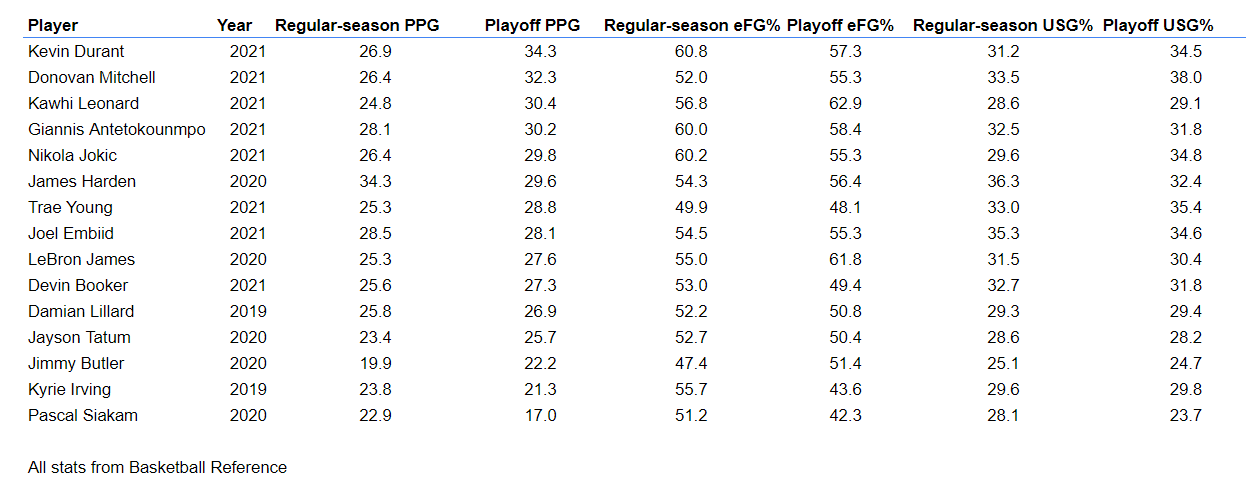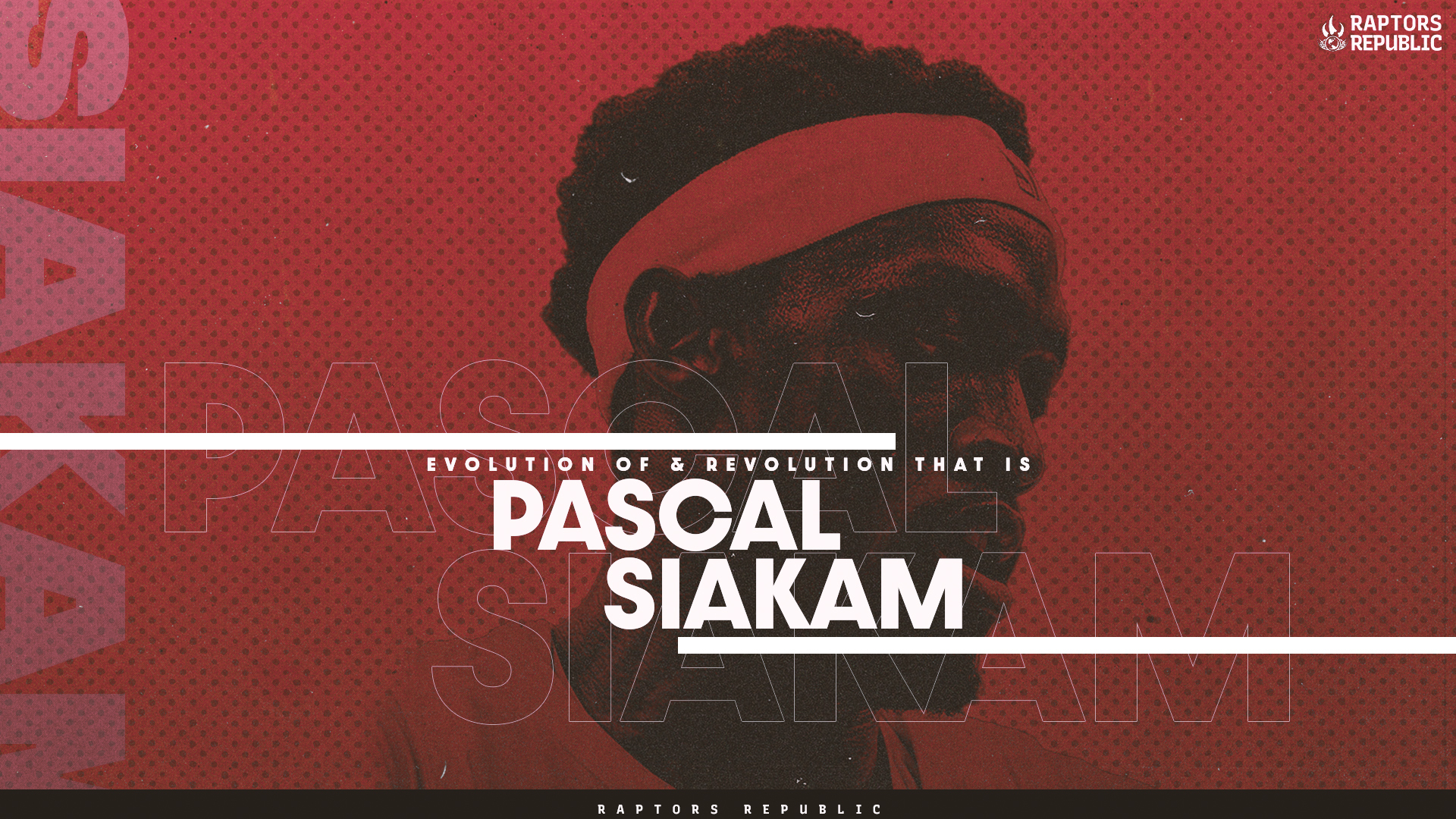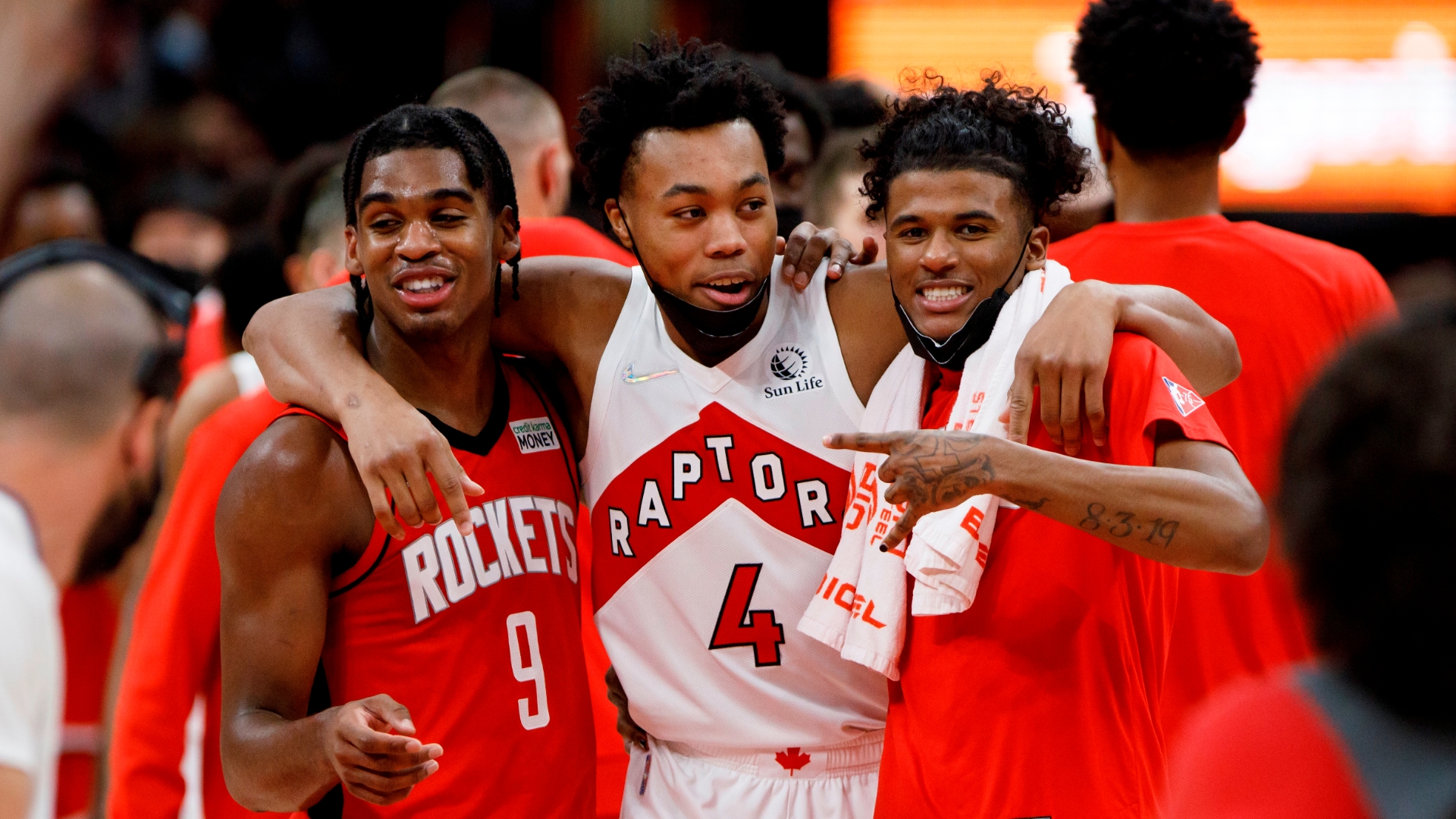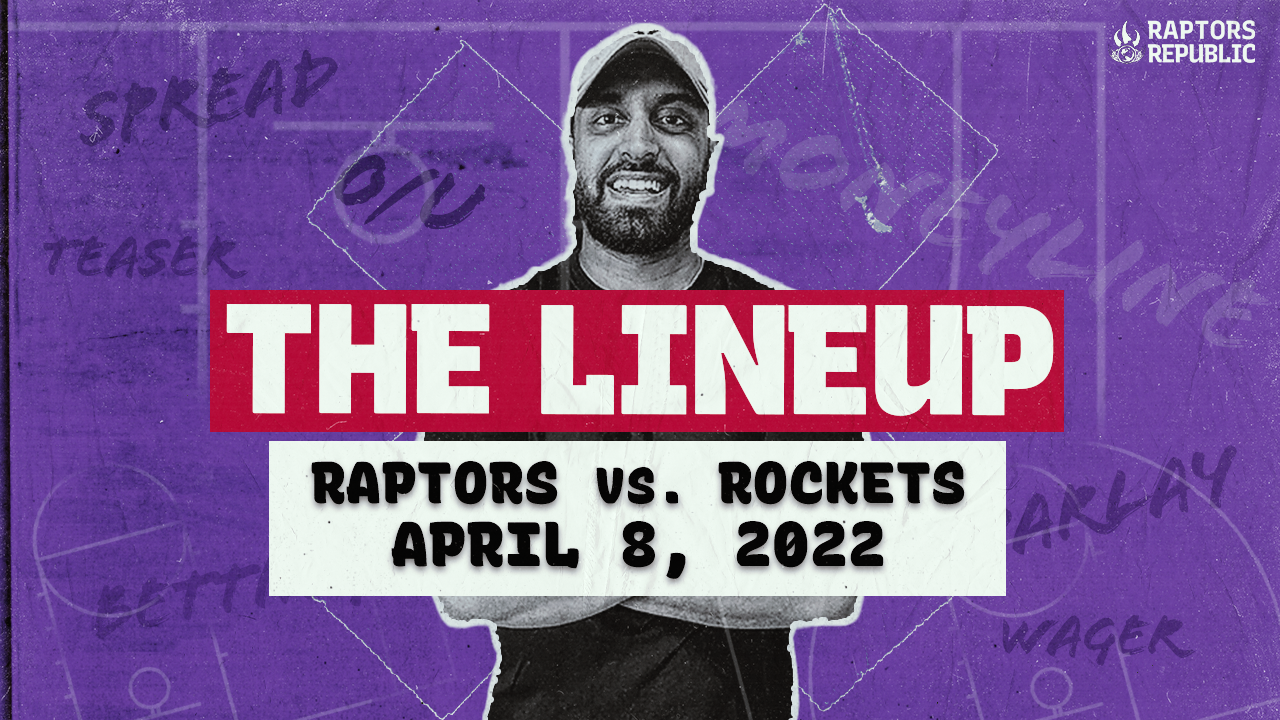Let’s do this correctly. An a priori definition, first:
- Superstar: A player who can lead a winning playoff team in usage. That’s not that crazy, right? Let’s toss in more specifics: by “winning playoff team,” we mean a team who wins at least one playoff series.
- Thus the filter here is looking at the eight teams that win a playoff series in a given year, and choosing which player leads that team in usage during that entire playoff run.
- Yes, of course, there’s a lot more to winning than usage. You don’t need to tell me. But this is a rough sketch. (Editor’s note, also me, but added in after I’ve done the research to look at the list of players: yeah, this encapsulates superstardom better than I expected, to be honest.)
That gives us eight players a season. Eight superstars a year, with plenty of crossover from season to season. It’s certainly not exhaustive — using just superstars from this past playoff run excludes injured superstars (Kawhi Leonard this season), multiple superstars on one team (Paul George in 2021) and clearly dominant players who can’t quite drag teams to the playoffs (LeBron James this season (lol)). To try to bridge that gap, let’s go back three years — not so far so as to include washed players (except for one), but still casting our net wide enough to gather a realistic sample. Remember, we’re working in theory here, not trying to re-legislate the hierarchy of the NBA. The goal is simply to give us a baseline with which to work. So let’s set that baseline, going back three years. Another definition:
- We’re also going to exclude older series from players who have accomplished “superstardom” more recently. (For example, Kevin Durant has led multiple winning teams in usage over multiple playoffs, but no need to include him twice.) The more recently a player has accomplished superstardom, the more relevant it is now. Because time is linear.
- That’s why this list has so few players from 2019, for example. Because most of the superstars from that playoffs were also superstars in 2020 or 2021.

Looking at that list, it’s pretty, pretty good. Yes, we’re missing Steph Curry and Luka Doncic and Mike Muscala and some others. But we’re looking to sketch as broadly as possible here, focusing on trends rather than specific data points, so that’s fine. This looks and feels like today’s list of superstars, and that’s relevant for our case. Because after all, this is decided by a jury of our peers. Another point: this is slightly broader than a “this guy could win a championship as his team’s scoring leader” list, which is really only four names deep at any given time. Perhaps that’s your definition of superstar, but ask yourself truly: was Dirk Nowitzki on that list before 2011? Was Leonard before 2019? Or Steph Curry before 2015? That list is defined by circular logic, more reactive than predictive. To be true to superstardom we need to pre-empt and predict, to choose a slightly broader list to catch all the players who could burst onto the scene and define an entire playoff run.
So now onto the important bit for the continuation of our case.
Perhaps most importantly, you’ll see that Pascal Siakam is already on the list. Yes, he’s at the bottom of the list with the lowest points per game over a winning playoffs, and he also has the lowest playoff effective field goal percentage (eFG), but he’s there. He led the 2019-20 Raptors team in usage rate in the regular season and the playoffs. We know the Raptors can win with Siakam as their leader, as they’ve done it before. (More on this later.)
But let’s move to some averages. This is what the “average” superstar from the past three years would look like in the regular season and the playoffs. And let’s just toss in Pascal Siakam’s numbers this year (playoffs, of course, excluded) for relevant comparison.

Siakam falls a tad short from the scoring average. But other players have done more with less, such as Jimmy Butler in the Bubble Playoffs or Siakam himself in the same. It’s not impossible for “lesser” superstars on this arbitrary ranking to still win playoff series. They have to be surrounded by extremely talented complementary players (Bam Adebayo for Butler and Kyle Lowry for Siakam) and elite defenses. Today’s Siakam has an All Star (hopefully healthy) in Fred VanVleet at his side and an increasingly terrifying, ghoulish defense the Raptors wield like a billy club at opponents’ heads. In those pieces to support what might be deemed a “lesser” superstar, this Raptors team has the juice to replicate what past winning playoff teams have accomplished.
But hold on there. Is Siakam really a lesser superstar at the moment? There’s more than meets the eye to this trial. Remember: Siakam missed the first month (almost) of the season with a torn labrum, and it took him a stretch to ramp up to his usual speed. He spent a week or two in first gear, shifted into second and third over the next month or so, and has blasted into Autobahn-speed since. If you just look at what Siakam has been since the start of 2022, which seems more likely to represent a predictive standard of play, given that his injury seems now to be behind him, he starts to resemble the Average Superstar with ease. He’s averaged 23.8 points per game on the same usage and an eFG percentage of 53.2. That’s more 2020 Jayson Tatum-y or 2021 Devin Booker-y than Bubble Butler-y. And Siakam has done it often within the most cramped spacing known to the 21st century.
And like the other superstars on the list, Siakam does a whole lot more than score efficiently. He just threw a 37-point, 12-assist, 11-rebound triple double at the Philadelphia 76ers. He’s averaging 5.2 assists per game, right in line with many of the other non-guards on the superstar list like Durant, Giannis Antetokounmpo, Leonard, and Butler, and a fair amount higher than Joel Embiid or Tatum. He plays better defense than all but four or five players on the list. Sure, Siakam doesn’t quite space the floor for his teammates like some of the best stars, but he’s up to 37.4 percent on catch-and-shoot threes, right in line with the given seasons for Embiid, Nikola Jokic, Devin Booker, Damian Lillard, and better than Trae Young, Butler, and himself (2020).
There’s not really much distance, statistically, that separates Siakam from any of these players. His scoring, efficiency, passing, defense, and catch-and-shoot shooting all rank tightly within their midst. Perhaps he’s not the same pull-up shooter from distance, but he gets his scoring in other ways: post-ups, most especially, and driving runners, hooks, and floaters through contact. Every star has his specialty, and Siakam is no different. Even his impact numbers, that reflect how a team plays with or without its leader, mirror those of other superstars. His on/offs per 100 possessions of +7.9 would rank almost smack dab in the middle of the pack of given superstars in their given winning-playoff seasons.
Siakam is doing this despite enjoying a usage rate second lowest of all, with only Bubble Butler’s mark smaller than his. He has room to do more with the ball, which is generally what happens in the playoffs. The average superstar of the past three seasons saw his usage go up (slightly) in the playoffs, with players like Donovan Mitchell, Jokic, and Durant seeing huge spikes. Siakam could handle a lot more. In fact, in games in which Siakam has seen a higher usage and more shot attempts, he’s been dramatically more efficient this season. He already faces among the most double teams in the NBA (as a good superstar should), so defenses have little extra to throw at him come playoff time. He can handle more offensive responsibility.
To that point, if Siakam is a bonefide superstar, then what’s to be expected from him come playoff time? He’ll likely see his usage spike by an above-average amount. He may well even score more points for the Raptors. And unless he’s Leonard or James, his efficiency is probably dropping in the playoffs. That’s extremely normal because even if players are used to extraordinary defensive attention, they still get fewer attempts in transition, fewer free throws, and in general fewer cheapo points. Siakam doesn’t get a lot of freebies anyway, with a fairly difficult shot diet subsisting on short-midrange attempts; he takes the second-highest rate of such shots in the league.
That’s all … kind of normal for superstars. Even his shot diet — hard shots! — is what’s to be expected for a superstar. Every part of his game, statistical or aesthetic, points in one direction. Samson Folk and I defended Siakam in November, predicting quite accurately what this season might become. Later, I wrote in February that “[Stardom is] not bright flashes, eruptions, moments of brilliance surrounded by moments of emptiness. A truth: We are not defined by our best days. Stardom is the sameness of performance, meeting expectations again and again as the moon spins and the tides turn, day in and day out. Stardom is boring. And that’s what Siakam has become.” Well, Siakam’s not been a star since then. He’s been better.
And if the Raptors manage to win a playoff series this year, Siakam will add himself to the list used as Exhibit A in this argument. (That the Raptors came close to ensuring themselves the 76ers in the first round by beating them on Apr. 7, and the 76ers seem to simply be an inferior team, does not hurt there.) But that’s completely beside the point. The definition of superstar here is admittedly arbitrary. The point was simply to draw a baseline, to blend the faces that make up the leaders of the NBA. And when that image comes together, it looks strikingly like Pascal Siakam.
If it walks like a superstar and it talks like a superstar, then it simply is a superstar. Yes, certainly, Siakam should join an All-NBA team at the end of the year. But superstardom is more than that. It is a tier of players who, given a hot streak and some luck at the right time, could lead their team to an NBA championship. Siakam is on that list. Perhaps his team isn’t ready to join him, young that his teammates are and relatively inexperienced in the playoffs. (Although the defense looks ready.) But Siakam is 28 years old and here to stay. The Raptors will improve around him, and the amount of “hot streak and luck at the right time” required for the Raptors to win the whole thing are going to shrink dramatically, very soon. Either way, the case is decided. No matter how you cut it, how you define the list, what statistic or aesthetic judgement you use, Siakam fits in. Pascal Siakam is an NBA superstar.



